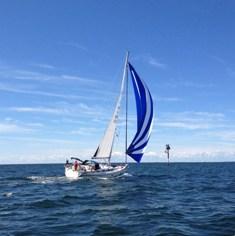
Text: Ralf Klenberg, Onninen Oy
The Baltic Sea has been an important part of my life since I was a small boy and it’s where my family has its roots too, dating back centuries. We moved permanently to Helsinki in the 1950s, but both my parents are from the Turku archipelago. Every year we would travel by boat to spend the summer with my grandparents on the island of Kemiö.
My more recent sailing trips with my own family are somewhat longer, reaching the southern parts of the Baltic as far as Denmark. We generally run down the coast of the Baltic countries and then back up the Swedish coast. It has been a pleasure to see the way services have improved over the past twenty years, especially in the guest marinas of Western Estonia. In the early days, refuelling in these harbours almost always involved a taxi and a trailer, transporting dozens of jerry cans from miles away. It usually took hours to refuel. We would pour hundreds of litres by hand into the fuel tanks, sometimes through a filter placed over the funnel to make sure the fuel was clean. Today almost every harbour has a proper refuelling point and septic tank emptying stations. Every year our “must visit” sailing destinations include particular natural and guest harbours in the Åland islands that we are especially fond of. The children and the grandchildren sometimes come along for a week at a time but the usual crew is my partner and the family dogs.
Over 50 years of “ploughing” the Baltic I’ve definitely noticed the way its condition has deteriorated, with the disappearance of the bladder wrack and the eutrophication of the water along the shoreline. It’s true that blue-green algae was seen in the sea back in the 1960s too, but this was clearly on a much smaller scale. Sailing also generally involves a certain amount of fishing, and I look back with nostalgia to past decades when all you had to do was haul vast catches out of the sea. Recently catches have been extremely poor, and full-sized flounder, for example, are much harder to catch than they used to be.
In 2000-2004 I served as the commodore of the Sipoo navigation club, a period during which it became compulsory for pleasure craft to empty their septic tanks at pump-out stations. The move was intended to reduce eutrophication of the Baltic Sea and I am happy to see leisure sailors doing their bit in this way. The members of several sailing clubs pay an annual membership fee to the Keep the Archipelago Tidy organisation and the money raised is used to maintain the “Roope the Seal” services throughout Finland’s sea and lake areas. These include waste recycling bins, earth closet toilets and floating pump-out stations.
It is wonderful to be working in a company which takes its responsibility for the state of the Baltic Sea seriously. Here I would like to quote the chair of Onninen’s board, Maarit Toivanen-Koivisto: “The partnership with the John Nurminen Foundation is a natural way for us to take our responsibility for the condition of the Baltic Sea. Onninen has sites in many other countries in the Baltic area besides Finland. In the Baltic countries, Poland and Russia, for example, measures to improve the efficiency of phosphorus removal are essential to safeguarding the good condition of the Baltic Sea. We are delighted that as well as through financial support we are able to increase the visibility of the valuable work carried out by the John Nurminen Foundation through our own channels and our own stakeholder groups.”
